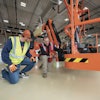
In mid-July, the Associated General Contractors of America (AGC) reported that June 2021 construction employment in 39 states remained below the pre-pandemic peak seen in February 2020. It has since released an analysis showing more long-term employment challenges across the U.S., with construction employment remaining stagnant, or declining, in 101 metro areas from February 2020 to June 2021.
Despite gains in U.S. economic growth, increased construction activity and the entry into the peak construction season, construction industry employment gains remained muted in June, with just under half the states reporting increases, one remaining stable and 25 states reporting modest declines.
As Ken Simonson, AGC chief economist, pointed out, “The construction industry is a long way from full recovery in most states, in spite of a hot homebuilding market in many areas. Soaring materials costs, long production times for key items and delayed deliveries are causing owners to postpone projects.”
Nonresidential Construction Still Feeling Pandemic Effects
The nonresidential construction sector continues to feel the impacts of the COVID-19 pandemic even as pent-up demand pushes general spending upward. Nonresidential spending is expected to decline an additional 3.9% in 2021 – on top of a 2% dip the prior year – before bouncing back 4.6% in 2022, according to a new report from the American Institute of Architects (AIA).
“Even while momentum is developing behind most of the nonresidential building sectors, there are several potential potholes on the road to a construction recovery,” stated Kermit Baker, AIA chief economist. He cited emerging inflationary pressures, global supply chain challenges, a potential housing bubble and a labor market that continues to be challenged.
“There are about 7.5 million workers in the [construction] industry and the unemployment rate is 7.5%,” he noted. "Still, after hiring over 300,000 workers in May, there were almost as many unfilled job openings in the industry.”
From February 2020 — the month before the pandemic caused project shutdowns and cancellations — to last month, construction employment increased in just 11 states and was flat in the District of Columbia, AGC reports.
In addition, of the 257 metro areas studied, construction employment fell or remained stagnant in 101 areas during the period. Eighty metro areas saw lower construction employment, while it remained unchanged in 21 areas.
“Typically, construction employment increases between February and June in all but 30 metro areas,” said Simonson. “The fact that more than three times as many metros as usual failed to add construction jobs, despite a hot housing market, is an indication of the continuing impact of the pandemic on both demand for nonresidential projects and the supply of workers.”
Click to view state February 2020-June 2021 data, 16-month rankings, one-month rankings, and map. Click to view the metro employment data, rankings, top 10 and map.
Legislative Steps Needed to Promote Employment Gains
AGC officials cautioned that industry employment is unlikely to grow more consistently across the U.S. until many of the supply chain challenges impacting construction improve. Steps cited that could help include removal of tariffs on key construction materials, including steel and aluminum, as well as by the ending of unemployment supplements implemented to aid families during the pandemic.
“Easing tariffs will help, but what the construction supply chain needs are workers to manufacture the products, ship them to contractors and build the projects the economy demands,” said Stephen E. Sandherr, AGC chief executive officer. “Unemployment supplements helped families survive the pandemic-related lockdowns, but they are undermining the post-pandemic recovery.”
Skilled labor positions have proven particularly hard to fill. A study of second-quarter data by the U.S. Chamber of Commerce showed 88% of contractors surveyed experienced moderate to high levels of difficulty finding skilled workers and nearly half (45%) of those saw a high level of difficulty. More than a third (35%) of those reporting difficulty finding workers have had to turn down work as a result.
As such, AGC officials are urging Congress and the Biden administration to make new investments in workforce development -- such as providing further funding for career and technical education -- a priority.
“Federal officials may talk about the value of craft careers like construction, but they are failing to put their money where their mouth is,” said Sandherr. “Until we expose more people to construction careers, and get a handle on soaring materials prices, the construction industry is likely to have a hard time recovering from the pandemic.”


















